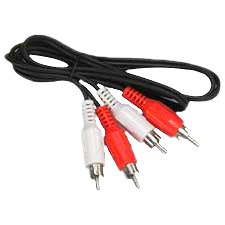SONOS Help
Need help using your new SONOS system? Here are some articles can help.
Also if you need you can schedule a tech to visit you on your own home. (Some charges may apply).
Set up Sonos S2 system
Before you start
Download from the App Store or Google Play Store the SONOS S2 App. ![]()
iOS or Android
- Open the Sonos S2 Controller app for iOS or Android.
- Choose Connect to exisiting Sonos system.
- Follow the on-screen instructions.
Unable to connect to Sonos
iOS 14 introduces a new app permission that needs to be enabled for the Sonos app to connect to your system. If you’ve updated to iOS 14, go to your iOS device’s Settings app, then go to Privacy > Local Network. Enable access for Sonos on this list to let the Sonos app connect.
Common fixes
Try these quick fixes first and see if your Sonos app reconnects to your system.
Check the power to your Sonos product
Make sure the power cord is securely plugged in to both the Sonos product and the power outlet. By default, your Sonos product will show a solid white light when it’s powered up and ready for use.
Unplug your router, then plug it back in
Give the router a minute or two to start up again. Make sure your phone, tablet, or computer has reconnected to the correct Wi-Fi network before checking the Sonos app again.
Make sure you’re connected to the right Wi-Fi network
Go to the Wi-Fi settings on your computer, phone, or tablet, and confirm it is connected to the same Wi-Fi network as Sonos. Check that your device isn’t connected to a guest network as this can prevent your device from connecting to Sonos.
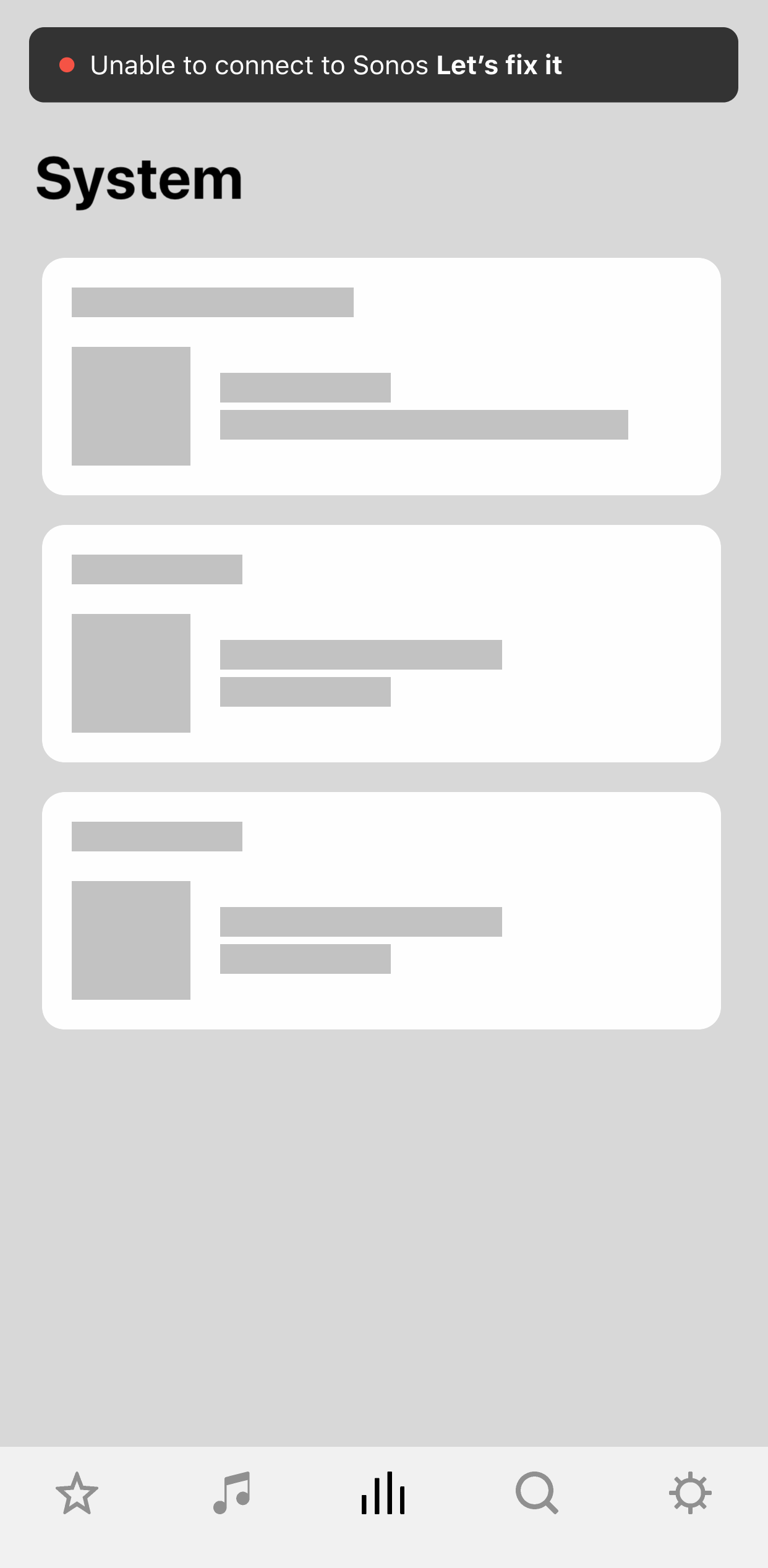
Connect to multiple Sonos systems
Sonos S2 app for iOS or Android
- Connect your device to the WiFi network that Sonos is on.
- Open the Sonos app.
- Tap Connect when you are prompted to control a nearby Sonos system.
- If you do not receive this prompt, go to the
Settings tab and tap Join nearby system.
- The app will prompt you to press and release the Join button on the nearest Sonos product if there is more than one Sonos system on this network.
- If you do not receive this prompt, go to the
- Follow the prompts to connect to the Sonos system.
Sonos S1 app for iOS or Android
- Connect your device to the WiFi network that Sonos is on.
- Open the Sonos app.
- When you see the message “Sonos found” at the top of the screen, tap Connect.
- Tap Let’s connect.
- The app will prompt you to press and release the Join button on the nearest Sonos product if there is more than one Sonos system on this network.
- Once you see “Connected to your Sonos system,” select Done.
Sonos S1 and S2 app for macOS or Windows
- Connect your device to the WiFi network that Sonos is on.
- Open the Sonos app.
- Tap Let’s Connect when you see the message “We found Sonos on your network.”
- Follow the prompts to connect to the Sonos system.
Now that your Sonos app is connected to multiple systems, it will automatically recognize them when your mobile device connects to their associated WiFi networks.
Group rooms
iOS or Android
- From the
System tab, tap
Group next to the selected room.
- Tap the rooms you want to add to the group, then tap Done. You can also tap Everywhere to group all of your rooms.
macOS or Windows
- From the Rooms pane on the left side of the app, click the
group button next to the selected room.
- Select the rooms you want to add to the group, then click Done. You can also click Select All – Party Mode to group all of your rooms.
Using the physical buttons on your products
Press and hold the play/pause button to group this room with another room (or group of rooms) that is currently playing.
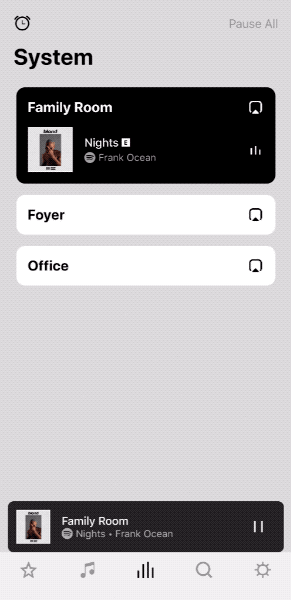
Ungroup rooms
iOS or Android
- From the
System tab, tap
Group next to the group you want to change.
- Tap the rooms you want to remove from the group, then tap Done.
macOS or Windows
- From the Rooms pane on the left side of the app, click the
group button next to the group you want to change.
- Click the rooms you want to remove from the group, then click Done.
Using the physical buttons on your products
Press and hold the play/pause button to ungroup a room from its current group.

Change the volume of grouped rooms
When two or more rooms are grouped, sliding the volume slider in the app will adjust the volume of all rooms in that group. You can adjust the volume of individual rooms in a group by using the physical volume buttons on your products, or from the Sonos app by following the steps below.
iOS or Android
- From the Now Playing screen, tap the volume slider at the bottom to view each room’s volume level.
- Move each slider to adjust the volume for that individual room.
macOS or Windows
- Click the volume slider in the top left of the app to view each room’s volume level.
- Move each slider to adjust the volume for that individual room.
Play Line-In on your Sonos Amp
This article will guide you through setting up Line-In on your Sonos Amp. The following steps also apply to Connect:Amp. Line-In allows you to connect a device that has an audio output (such as a CD player or turntable) to play out of your Sonos system. Note that Line-In is disabled when Amp or Connect:Amp is being used to power surround speakers in a Sonos home theater.
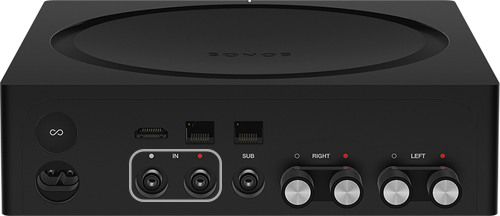
RCA
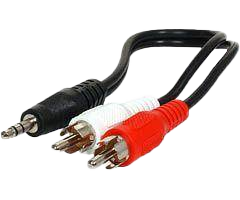
RCA to ⅛” (3.5mm)
Attach audio cable
- Plug the RCA end of the cable into the corresponding red and white inputs labeled IN on the back of your Amp.
- Depending on the outputs of your source device, plug the RCA or 1/8″ (3.5mm) end of the cable into the corresponding output on your source device or preamp.
- Start playing something from your source device.
- Open the Sonos app for iOS or Android.
- From the Browse tab, tap Line-In.
- Tap the source device to start playback through Sonos.
Share Roam’s Bluetooth audio with your Sonos system
While Roam is in Bluetooth mode, it will stay connected to the rest of your Sonos system as long as it’s still within range of your Wi-Fi network. This means that while your Roam is playing Bluetooth audio, you can group it with other Sonos products in the same system. Follow the steps below to group your Roam in Bluetooth mode with your other Sonos products.
iOS or Android
- From the
System tab, press
Group next to the Roam playing Bluetooth audio.
- Press the rooms you want to add to the group, then press Done.
macOS or Windows
- From the Rooms pane on the left side of the app, click the
Group button next to the Roam playing Bluetooth audio.
- Select the rooms you want to add to the group, then click Done.
Play music stored on your iPhone, iPad, or iPod touch
Keep my music on my iOS device
Apple AirPlay 2
AirPlay is our recommended method for playing music stored on your iOS device to Sonos. See our article on using AirPlay to learn which Sonos products support AirPlay and how to use AirPlay with Sonos.
Bluetooth on Sonos Move or Roam
If you have a Sonos Move or Roam, you can connect your iOS device via Bluetooth to play your downloaded music. See our article on using Bluetooth for more information.
Move my music to my computer or streaming service
Music library on a Mac, PC, or NAS drive
If you’re able to store your music on a Mac, PC, or a network-attached storage (NAS) drive, you can share it to Sonos using the Sonos app for macOS or Windows. Once your music library is set up you can browse and play that music from the Sonos app on your iOS device. See our article on setting up a music library to get started.
Streaming services
Some services allow you to upload and stream your music online. We support the following services that let you upload your own music. Note that some of these services require a premium subscription to work with Sonos.
- Apple Music
- YouTube Music
- Deezer
- Plex
See our article on adding music services to get started with using one of the services listed above.
Stream AirPlay audio to Sonos
Use AirPlay on your iPhone, iPad, or Mac to stream your favorite music, movies, podcasts and other audio directly to your Sonos products.
Sonos supports streaming AirPlay 2 audio from any device listed in Apple’s AirPlay system requirements article. You can also use AirPlay 1 to stream system audio from macOS to Sonos, but you may experience a delay or audio interruptions.
Start an AirPlay stream using an iPhone or iPad
You can stream your iOS device’s audio to supported Sonos products using Control Center. Follow the steps below to start sending iOS audio to Sonos using AirPlay.
- On your iPhone or iPad, open Control Center by swiping down from the top right of the screen. If you’re using an iPhone 8 or earlier, you can open Control Center by swiping up from the bottom of the screen.
- Find the audio card in the upper right-hand corner, then tap the
 AirPlay icon.
AirPlay icon. - Tap one or more Sonos products to stream the same audio across all of them using AirPlay.
You can also play AirPlay audio directly from some iOS apps, like Apple Music. Just open the app, tap the ![]() AirPlay icon, then choose a product.
AirPlay icon, then choose a product.
Start an AirPlay stream using a Mac
You can stream your Mac’s audio to supported Sonos products by following the steps below.
- Open your Mac’s System Preferences and click Sound.
- In the Output tab, choose a Sonos product to begin an AirPlay stream.
If you have it enabled, you can also select a Sonos product by clicking the Volume tab in the top-right corner of your screen
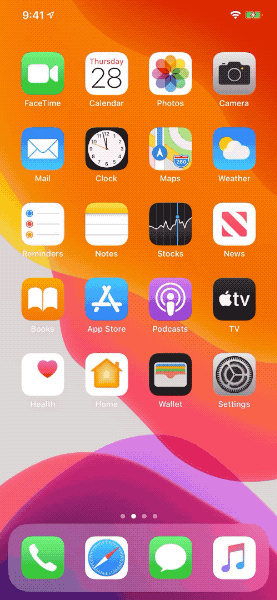
Sonos compatibility with AirPlay
The following Sonos products are compatible with AirPlay:
- Amp
- Arc
- Beam
- Beam (Gen 2)
- Five
- Move
- One
- One SL
- Play:5 (Gen 2)
- Playbase
- Port
- Roam
- SYMFONISK WiFi bookshelf speaker
- SYMFONISK table lamp with WiFi speaker
- SYMFONISK picture frame with Wi-Fi speaker
Play music stored on your Android device
Audio files downloaded to your Android device can be played on your Sonos system using the Sonos app. This article will show you how to manage your downloaded music to ensure it appears in the Sonos app and how to play it on your Sonos products.
Before you start
- Make sure your Android device is supported by Sonos and the Sonos app is up to date.
- Make sure your audio files are in a format supported by Sonos.
- Place your downloaded audio files in the Music folder on your Android device. If your audio files are not in the Music folder they will not appear in the Sonos app.
Play music from “This Mobile Device”
- Open the Sonos app for Android.
- From the ♫ Browse tab, tap This Mobile Device.
- Choose the music you want to play.
When playing tracks from your Android device, it needs to stay powered on and connected to your network. If the device goes offline, other Sonos apps will show an error message if they try to play Android tracks that are still in your queue. If that Android device is no longer available, clear out its tracks from the queue to prevent any further errors.
Listen to podcasts on Sonos
This article will show you how to listen to podcasts on Sonos. You can stream podcasts to Sonos using direct control, AirPlay, the Sonos app, or play downloaded podcasts using a Sonos music library.
Stream podcasts using Apple AirPlay or direct control
The easiest way to stream podcasts to Sonos is by using AirPlay on a supported iOS or macOS device or using a service that supports direct control.
AirPlay
If you have a supported iOS or macOS device, you can stream any audio from that device directly to Sonos using AirPlay, including audio from your podcast app. See our article on using AirPlay with Sonos for more information.
Direct control
Services like Spotify and iHeartRadio support direct control. Direct control lets you play a podcast within the service’s app, then cast the audio directly to Sonos.
Stream podcasts from the Sonos app
Some services let you browse, search, and play podcasts from within the Sonos app. Not all services that provide podcasts will have their podcast catalogs available in the Sonos app via browsing or searching. If you can’t find the podcast you’re looking for in the Sonos app, we recommend using direct control or AirPlay.
Browse
- Open the Sonos app for iOS or Android.
- Tap the ♫ Browse tab.
- Tap the desired service to browse their content.
Search
- Open the Sonos app for iOS or Android.
- Tap the
Search tab.
- Tap the Podcasts & Shows filter at the top.
- Search for a podcast.
Stream downloaded podcasts to Sonos
Podcasts stored on an Android device
Download the podcasts to your Podcasts folder on your Android device. For podcasts to show up in the Sonos app under On This Device, they must reside in the Podcasts folder on your Android controller. The podcasts folder should be in the root directory of your Android device. If you have podcasts located in your Music folder, the podcasts will be listed under Music, not Podcasts. For more information see our article about playing music stored on your Android device.
Podcasts stored on a computer
If you have podcasts downloaded to a macOS or Windows computer, you can play these on Sonos by adding them to a Sonos Music Library.
Add a music service to Sonos
This article will show you how to browse available music services and add them to Sonos. You can also add multiple accounts for the same service by following the steps below for each account. Then see our article on using multiple accounts to learn how to switch between them.
iOS or Android:
- Open the Sonos app.
- From the Settings tab, tap Services & Voice.
- Under Music & Content, tap Add a Service.
- Tap the service you would like to add.
- Tap Add to Sonos.
- Follow the on-screen instructions to add the music service account.
Mac or PC:
- Open the Sonos app.
- Under the Select a Music Source section, click on Add Music Services.
- Click on the service you would like to add.
- Follow the on-screen instructions to add the music service account.
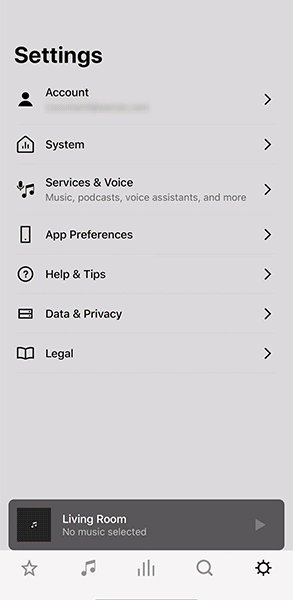
Use multiple accounts for the same music service
You can add and switch between multiple accounts for the same music service by following the steps below. Adding multiple accounts requires that you provide a name for each account. Ensure that each account has a unique name to make them easy to identify.
Add multiple accounts
Adding another music service account follows the same process outlined in our Add a music service to Sonos article.
If one or more accounts have already been added for a music service, you’ll see each account name displayed below the service’s description in the Add Music Services screen.
Switch between accounts
iOS or Android:
- Go to ♫ Browse and choose the music service with multiple accounts.
- Tap the account name at the top to reveal a list of added accounts.
- Tap the account you wish to use.
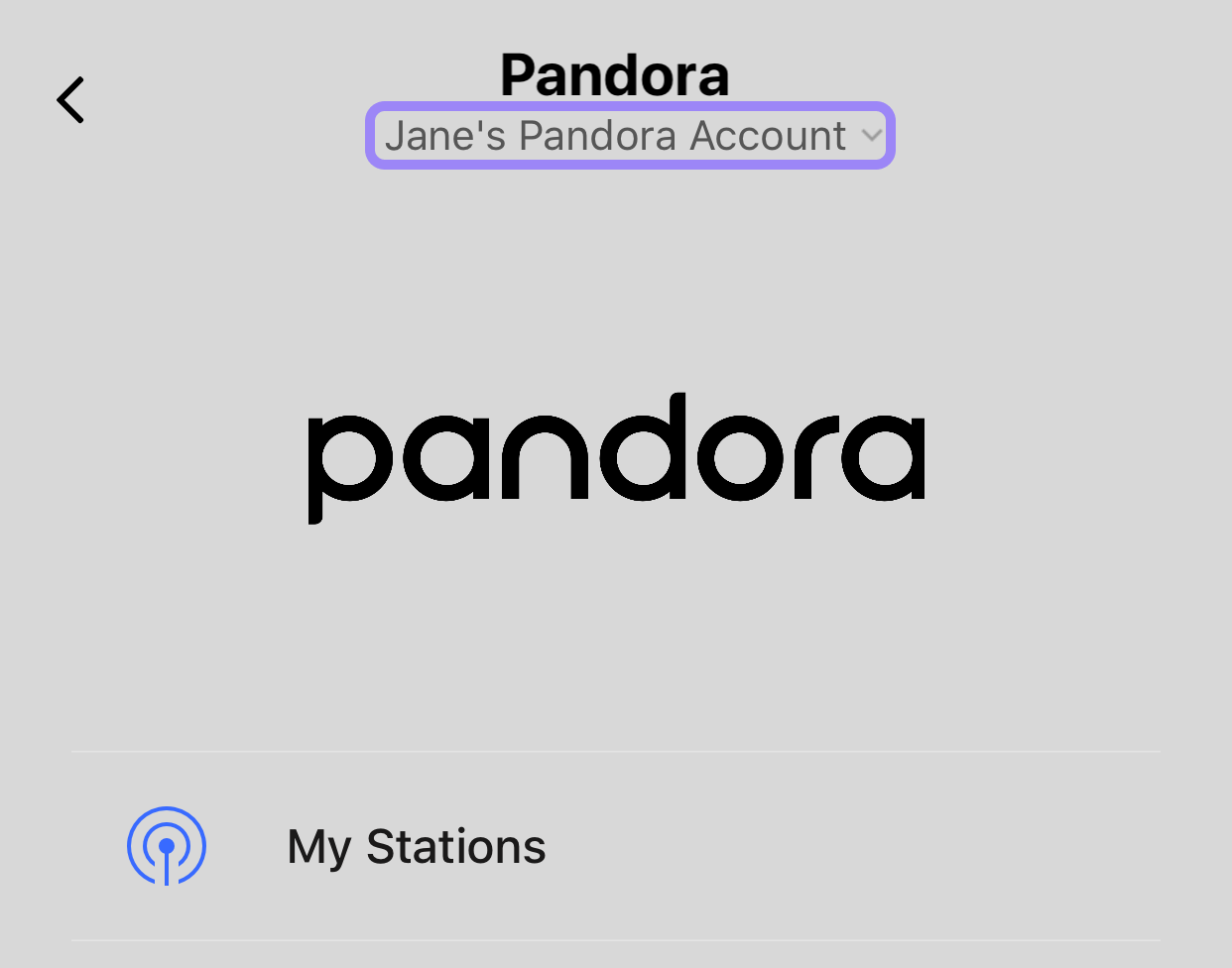
macOS or Windows:
- From the Select a Music Source panel, tap the triangle to the right of the service name to reveal a list of added accounts.
- Click on the account you wish to use.
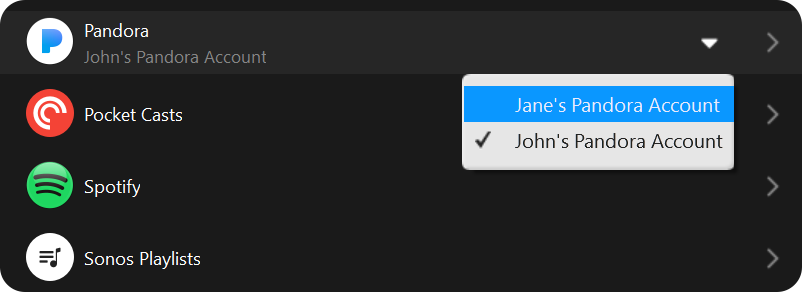
Add favorites to My Sonos
This article provides steps to add your favorite songs, stations, podcasts, or collections like “New Releases” to My Sonos, providing a shortcut to the content you listen to the most.
iOS and Android
While browsing music
- Tap the
button next to any listed item, such as a song, album, or artist.
- Tap Add to My Sonos.
- With some services, you may need to scroll down and tap More first before you’ll see the Add to My Sonos option.
From the Now Playing screen
- While Sonos is playing audio, open the Now Playing screen.
- On the right-hand side, tap the
icon on iOS or the
icon on Android to open the Info & Options menu.
- Tap Add to My Sonos.
- With some services, you may need to scroll down and tap More first before you’ll see the Add to My Sonos option.

Set an alarm on Sonos
Use alarms to wake up to your favorite songs in the morning, or setup reminders throughout the day. Follow the instructions below to configure alarms for your Sonos.
To set a Sonos alarm using iOS or Android:
- From the Rooms tab, tap the
Alarm icon.
- Tap New Alarm.
- Set the Time, Room, Music, Repeat, Volume, and Alarm Duration, and tap Save.
- Tap Done.
Alarms can also be accessed from the Settings tab by going to System > Alarms.
Additional details
If you check Include grouped rooms, the alarm will play in the rooms that are grouped together at the time the alarm goes off. It does not play in the rooms that were grouped when the alarm was originally added to the Sonos system.
To play tracks from your local Music Library, first add the track to a Sonos Playlist or Imported Playlists then select the playlist as the alarm source.
The max number of alarms you can set up on Sonos is 32.
Alarm settings are not available when the Sonos app is not connected to your Sonos system.
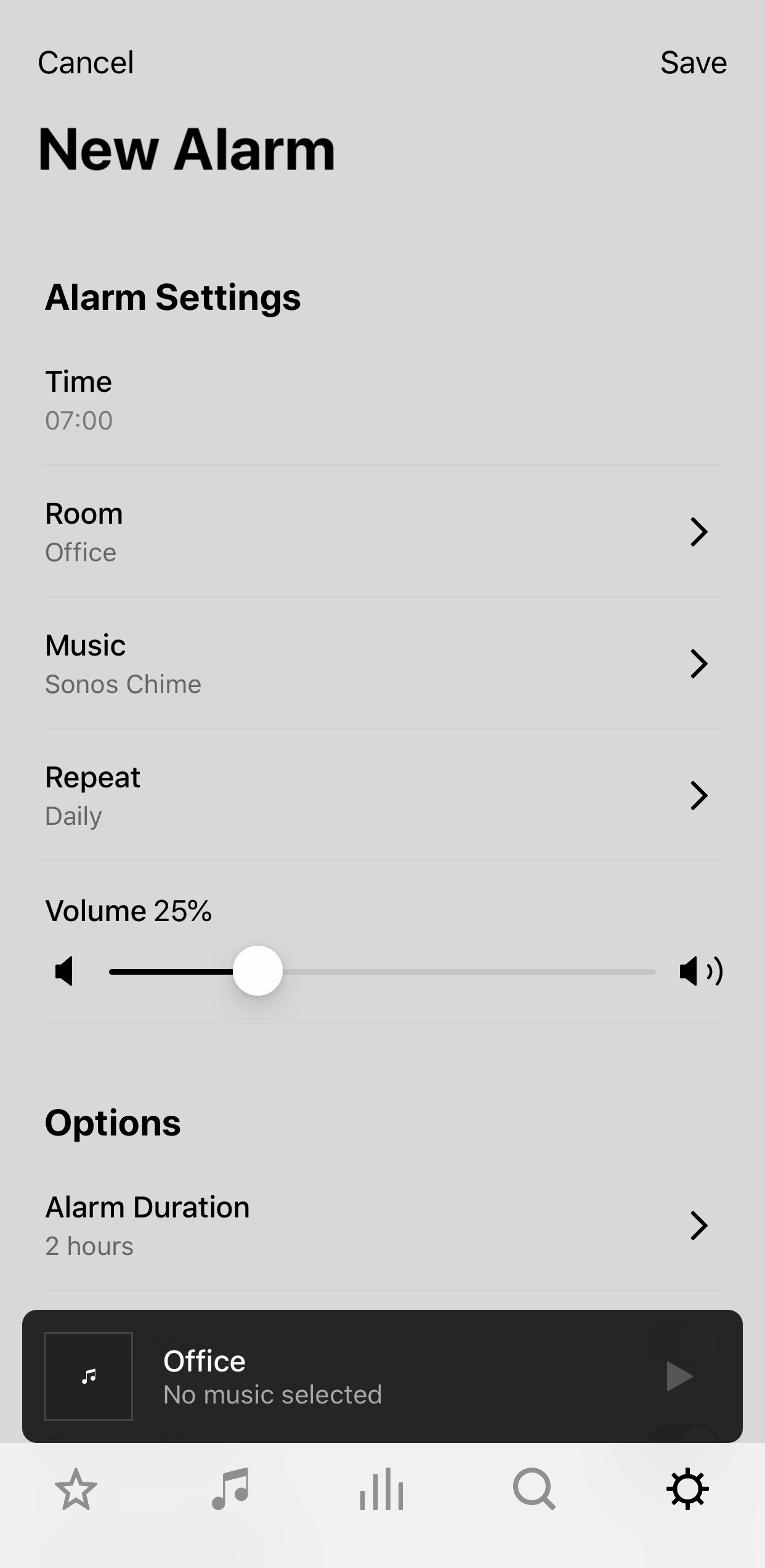
To set a Sonos alarm using a Mac or PC:
- Click Alarms from the bottom of the Select a Music Source pane on the right side of the Sonos app.
- On a Mac, click the
 to create a new alarm.
to create a new alarm. - On a PC, click Add to create a new alarm.
- On a Mac, click the
- Set the Time, Room, Music, Frequency and Volume.
- If you check Include grouped rooms, the alarm will play in the rooms that are grouped together at the time the alarm goes off. It does not play in the rooms that were grouped when the alarm was originally added to the Sonos system.
- If you check Shuffle music, the play mode for the selected alarm music will be set to shuffle.
- Click OK to save the alarm.
Controlling alarms from your lock screen
When a Sonos alarm goes off, it will appear on the lock screen of your iOS or Android device. You can use the notification to open the Sonos app in order to Snooze or Dismiss the alarm. On iOS, you can 3D Touch the notification to access a quick menu for these options.
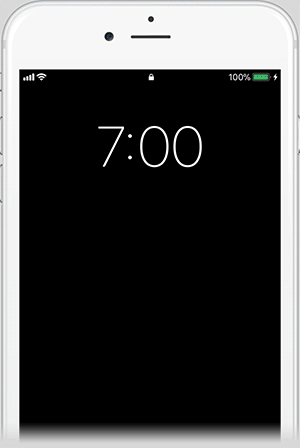
Control Sonos with Amazon Alexa
This article will explain how to control your Sonos system using Amazon Alexa. See our article on setting up Amazon Alexa on Sonos if you have not set it up already.
Basic commands
Amazon Alexa on Sonos allows you to use basic playback commands like play, pause, skip, and volume up/down. You can find more specific examples of playback commands on the Sonos skill page. Below are some tips for controlling Sonos with Amazon Alexa:
- When you ask Alexa to play music, it will begin playing from your default music service.
- You can select a preferred speaker when setting up an Alexa Smart Home Device Group so music plays in a specific room without saying the room name.
TV commands
Amazon Alexa can control your TV if you have a Sonos product connected to the TV via HDMI-ARC. Here are some commands you can use with your TV:
- “Alexa, turn on/off the TV.”
- “Aexa, turn up the volume on the TV.”
- “Alexa, set mode to TV.”
- “Alexa, switch to Speech Enhancement mode in the Living Room.”
- “Alexa, switch to Night mode in the Living Room.”
Not currently supported
- Playing songs based on lyrics
- Setting Sonos alarms and sleep timers
- Thumbs up/down initiated with voice is not reflected in the Sonos app
- Voice Calling
- Whisper Mode
- Drop In
- Playing songs from your Sonos music library
Set up an Amazon Alexa device to control Sonos
This article will help you set up an Amazon Alexa device, like an Echo or Echo Dot, to control Sonos. You can also add Amazon Alexa directly to your voice-enabled Sonos speaker.
Before you start
- Check if Amazon Alexa is available on Sonos in your region.
- Download the Alexa app and set up your Amazon Alexa device. Any Alexa-enabled device can control Sonos as long as the Sonos skill is enabled.
- Make sure your Sonos system has been set up, and that your system is running the latest software version.

Enable the Sonos skill
- Open the Sonos app for iOS or Android.
- From the Settings tab, tap Services & Voice > Add a Service > Amazon Alexa > Add Amazon Alexa.
- After being redirected to the Alexa app, tap Enable to use to sign in to your Sonos account and enable the Sonos skill.


Discover devices in the Alexa app
After enabling the Sonos skill, the Alexa app will prompt you to Discover Devices. Alexa needs to go through this discovery process so it knows what names you’ve given to your Sonos products. You can also tell Alexa to Discover Devices by saying “Alexa, discover my devices.”

Use Amazon Alexa with Sonos
After Alexa is set up, try some commands to play music on Sonos to make sure it’s working properly. You can also set up some Alexa Groups for a more seamless experience.
Products missing from the Sonos app
This article will help you bring back a Sonos product that has disappeared from your Sonos app. The steps below apply to a Sonos system that’s still working, but is missing one or more products in the Rooms list.
If you can’t use your Sonos system at all and your app is showing an “Unable to connect to Sonos” error message, see our article Unable to connect to Sonos.
Quick fixes for a missing Sonos product
Use “Find Missing Products” in the Sonos app
The Sonos app for iOS and Android can help you reconnect a missing product. From the Settings tab, go to Support > Find Missing Products and follow the on-screen steps.
Check the power on the missing product
Your Sonos product may have disappeared from your Rooms list if it has lost power. Make sure the product’s power cord is plugged in firmly and connected to a working power outlet.
You can check if a Sonos product is powered on and responding by pressing the Play/Pause button and seeing if the status light reacts.
Reboot the missing product
Remove the power cable from the Sonos product, wait five seconds, then plug the cable back in. The white status light will blink while the product is powering up. When the product has finished powering up, check the Sonos app to see if it has reappeared.
If the product is showing a flashing green light after powering up, you’ll need to call us.
Reboot your router
Unplug your router from power for ten seconds and then plug it back in. Your router may take several minutes to come back online. When your network is back, check your Sonos app to see if your product has reappeared.
Preventing Sonos products from disappearing
Move the Sonos product closer to the router
If your Sonos product is far from the router, it may be struggling to stay connected to your wireless network. Try moving the product closer to the router to prevent future drops. If your Sonos system is in a wired setup, move the product closer to the next closest Sonos product instead.
Clear up any wireless interference
Wireless interference can contribute to issues like Sonos products disappearing from the app.
Portable Sonos speakers appear as “Offline”
Move
Move will appear as “Offline” in the Sonos app when it is in Bluetooth mode, turned off or asleep, or when it is out of range of the Wi-Fi network.
Make sure Move is powered on, charged, and in Wi-Fi mode by checking the top LED. A blue LED indicates your Move is in Bluetooth mode. To switch Move to Wi-Fi mode, press the mode button once. For more information, see our article on using Move with Bluetooth.
Bring your Sonos Move closer to your Wi-Fi router. Your Sonos Move needs to be in range of your Wi-Fi network, even if it’s placed near another Sonos product. The Move can connect to your router’s Wi-Fi network but not the separate wireless network created by a wired Sonos product.
Roam
Roam will appear as “Offline” in the Sonos app when it is turned off, asleep, or out of range of the Wi-Fi network.
Make sure Roam is powered on and awake when trying to access it in the app. You may need to bring Roam closer to your router in order to keep it in range of your Wi-Fi network.
After changing routers or Wi-Fi settings
When reconnecting Sonos after changing your router or Wi-Fi settings, your portable Sonos product can appear offline if it did not receive the new Wi-Fi password. You can provide the new password by going to the Settings tab in the Sonos app for iOS or Android and tapping Use (product) on new network.

